by Lisa Cooke | Jan 11, 2015 | 01 What's New, British, Newspaper, Research Skills
The British Newspaper Archive celebrated its 3rd birthday recently by looking back at how people are searching its 9 million+ newspaper pages. To date, the five  most common searches are:
most common searches are:
1. Football
2. Murder
3. Death
4. Jack the Ripper
5. Railway
Not what you expected? Your digitized newspaper searches as a family historian may be a little more specific and less sports-and-murder oriented. But are they too general to yield successful results?
Here’s a tip from Lisa: “With 9 million searchable pages, the key to finding what you want is to use the Advanced Search.
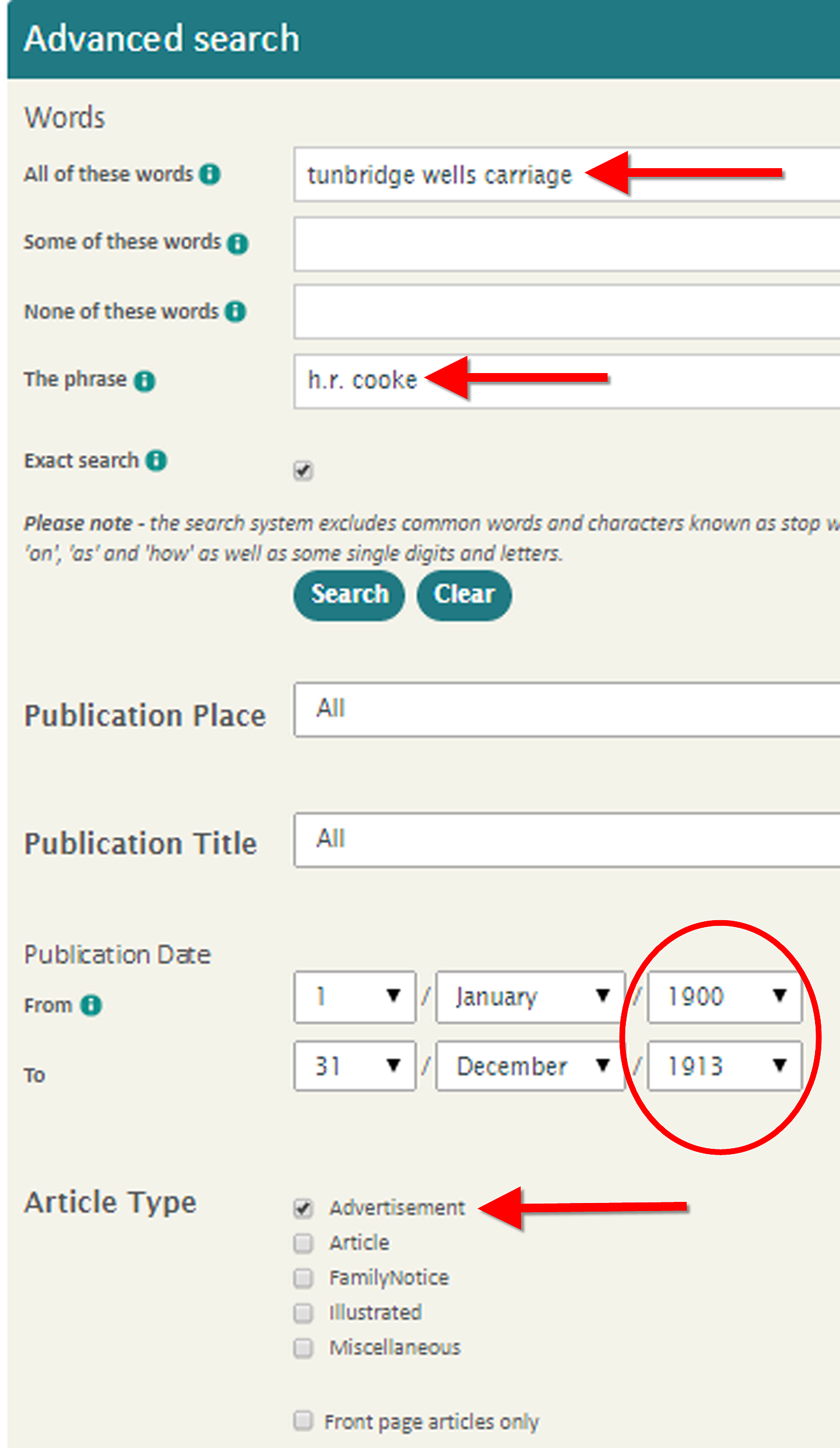 “You’ll find it under the search box. My initial search for my husband’s great grandfather resulted in tens of thousands of hits until I included mandatory keywords, his name as a phrase, a defined time frame, and zeroed in on advertisements. The 299 results were far more manageable and resulted in several fantastic finds!”
“You’ll find it under the search box. My initial search for my husband’s great grandfather resulted in tens of thousands of hits until I included mandatory keywords, his name as a phrase, a defined time frame, and zeroed in on advertisements. The 299 results were far more manageable and resulted in several fantastic finds!”
Armed with these tips, those with Irish or English roots should explore The British Newspaper Archive, even if you’ve searched there before. “We’ve come a long way since the website launched on 29 November 2011 with 4 million historic newspaper pages,” says a press release. “The collection is now more than twice the size, with over 9 million fully searchable pages available from 300 British and Irish titles. The newspapers cover 1710 – 1954, a much broader time period than at launch. If you weren’t able to find a particular person, event or place when The British Newspaper Archive launched, it’s well worth looking again now.” Visit www.britishnewspaperarchive.co.uk to try a search for free.”
Learn more about searching historical newspapers in Lisa’s book, How to Find Your Family History in Newspapers. Chapter 4 is all about the newspaper search process, and includes a copy-able Newspaper Research Worksheet.
Last of all, check out this fun infographic below from the British Newspaper Archive in honor of its birthday:
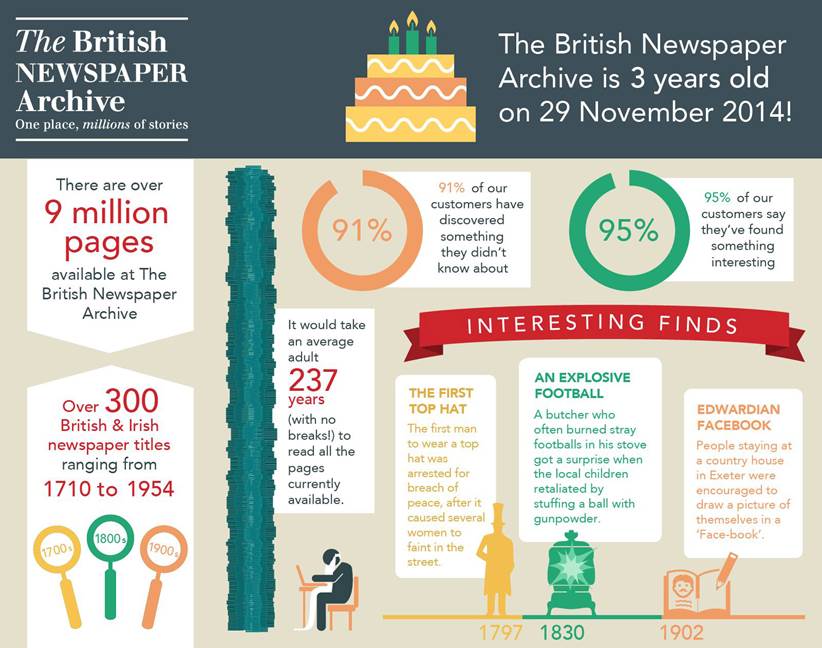
by Lisa Cooke | Jan 10, 2015 | 01 What's New, German, History, Jewish
A new exhibit at the Jewish Museum of Milwaukee tells the story of some 1939 dress designs that made it out of Nazi-occupied territory–and pays tribute to their designer, who didn’t.
“When the Nazis occupied Czechoslovakia in 1939, tens of thousands of Jews applied for visas to anywhere,” explains the caption to a YouTube video about the exhibit (see below). “Among them, Paul Strnad and his wife Hedy, a dress designer. Ultimately, neither would get a visa to leave Czechoslovakia.”
Years later, their story was literally stitched together by descendants and local historians. The couple sent her dress designs to a cousin in Milwaukee in a desperate attempt to get work visas to leave. It never happened. Paul was killed. Hedy’s fate is unknown.
A few years ago, the designs were rediscovered along with letters that told their story. Now the design drawings–and dresses newly created from them–are the centerpiece of “Stitching History from the Holocaust,” an exhibit at the Jewish Museum of Milwaukee. Read more about the exhibit here, or click below to watch this video about it. I think you will be as moved as I am to hear this story.
by Lisa Cooke | Jan 9, 2015 | 01 What's New, Ancestry, Newspaper, Research Skills
 Recently Sue from Elk Grove, Illinois wrote in with a question about what to do when records were lost due to fire (or war, or disasters, etc.):
Recently Sue from Elk Grove, Illinois wrote in with a question about what to do when records were lost due to fire (or war, or disasters, etc.):
“We have been trying to locate information on my great great grandparents Hugh and Mae Sullivan. I have never been able to find marriage or birth records and have realized that it was mainly due to the Great Chicago Fire of 1871. Interestingly, through a directory from 1866, they may have lived only blocks from the origin of the fire. I have them in 1880 with 4 sons, the first of which was born just 10 months following the fire.
“I suspect that they may have lost other children in the tragedy. I am unsure which direction to go to find more of their story and any suggestions would be helpful. Several newspapers are reported to have lists of the missing but I have either been unable to read them or to locate them. Sam Fink’s list [an index of Cook County marriages and deaths] did not provide any information. I suspect that my ancestors were among the very poor immigrants that flooded into Chicago. There were relief societies and I have wondered if records were kept of those who were rehoused.”
Here’s my response to Sue:
 I think you are on the right track with newspapers. Newspapers.com (owned by Ancestry) carries the Chicago Daily from 1871. Here is a screen shot of the List of Missing from Oct. 11, 1871. It might be worth a subscription to Newspapers.com to be able to really comb through all the issues.
I think you are on the right track with newspapers. Newspapers.com (owned by Ancestry) carries the Chicago Daily from 1871. Here is a screen shot of the List of Missing from Oct. 11, 1871. It might be worth a subscription to Newspapers.com to be able to really comb through all the issues.
 Here’s a tip on working with less-than-the best digital images of historical newspapers. You can “invert” the actual image (have it read white-on-black instead of black-on-white), then darken it and add a little more contrast to get the most readable copy possible. This can be done right from the Newpapers.com viewer.
Here’s a tip on working with less-than-the best digital images of historical newspapers. You can “invert” the actual image (have it read white-on-black instead of black-on-white), then darken it and add a little more contrast to get the most readable copy possible. This can be done right from the Newpapers.com viewer.
Also, in Family History podcast episode #37 I discussed a book specifically on Chicago research: Finding Your Chicago Ancestors: A Beginners Guide To Family History In The City Of Chicago by Grace DuMelle. As I recall, it was a very comprehensive book and could give you good leads on where to look.
by Grace DuMelle. As I recall, it was a very comprehensive book and could give you good leads on where to look.
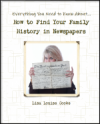
For more tips like these, read my book How to Find Your Family History in Newspapers. Inside you’ll find:
- Step-by-Step Instructions
- Worksheets and Checklists
- Tech Tools You Probably Aren’t Using But Should
- A Massive Amount of Location Specific Websites and a Case Study that Puts It Al Together
by Lisa Cooke | Jan 7, 2015 | 01 What's New, Adoption, Book Club, History
The Genealogy Gems Book Club debuted to excellent response from you, our readers and listeners and social media followers! A LOT of you are passionate about books and family history!
Our last title was a memoir by a woman raised in England who told a story about her South African roots. So what’s the new book? Well, we’re going to cross the sea–and genres–to a novel by U.S. author Christina Baker Kline.
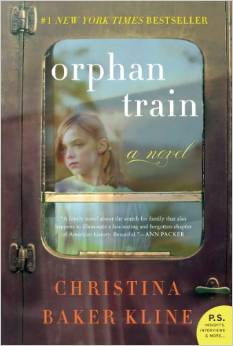 Orphan Train
Orphan Train spent five weeks at the #1 spot on the New York Times Bestselling list. When you read it you’ll see why. Here’s the storyline:
spent five weeks at the #1 spot on the New York Times Bestselling list. When you read it you’ll see why. Here’s the storyline:
Vivian is an Irish immigrant child who loses her family in New York City and is forced to ride the ‘orphan train.’ Orphan trains were a common solution in the late 1800s and early 1900s for care of abandoned or orphaned children in New York City and other places. The children were loaded onto trains and paraded in front of locals at various stops across the countryside, where they might be claimed by just about anyone.
After following Vivian’s life through her childhood and young adulthood, we fast-forward. Vivian is 91, and a teenage girl named Molly comes to help her clean out her attic. Molly is a Penobscot Indian who is in the modern foster care system. Gradually they realize they have a lot in common, and you’ll love the ways they each respond to that.
Why did I choose this book for family history lovers to read? To me, the book is about the importance of family identity. Each of us has a family storyline that existed before we were born and brought us into being. Vivian’s and Molly’s experiences remind me how important it is to know and value our family backgrounds. Of course I loved learning more about orphan train riders, too. That chapter of history is now a vivid reality to me.
Click here to order your copy of Orphan Train
When you initiate your purchase here, you are helping support the FREE Genealogy Gems podcast and the Book Club, whether you choose an e-book, or new or used print book on Amazon. Thank you! Then stay tuned–we’ll chat a little more about the book in the February podcast and the author herself will join us in March for an exclusive interview.
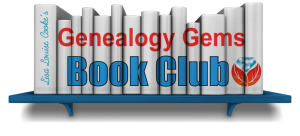 Click here to learn more about the Genealogy Gems Book Club and to see books we’ve featured in the past.
Click here to learn more about the Genealogy Gems Book Club and to see books we’ve featured in the past.
by Lisa Cooke | Jan 7, 2015 | 01 What's New, Conferences, RootsTech
RootsTech 2015 is just over a month away! Are you going? Genealogy Gems will be there in booth 1242 and we look forward to meeting you!
And, as recently announced, former First Lady Laura Bush will be at RootsTech, as she joins an already-impressive who’s-who list of this year’s keynote speakers and entertainers.
Laura Bush and her daughter Jenna Bush Hager will keynote the Friday morning general session on February 13. According to a FamilySearch press release, “The former First Lady will talk about life in the White House and the importance of family during those eight years, as well as reflect on the difficult days following September 11th. Jenna Bush Hager will join her mother onstage for a fireside chat where they will share family stories as a new mother and grandmother.”
Last year, over 9000 people from 31 countries attended this forward-thinking gen-tech conference in person. An estimated 150,000 viewed live-streaming sessions around the world. It’s tough to argue with RootsTech’s claim as “the largest family history conference in the world.” Visit us at the Genealogy Gems booth in the Expo Hall!
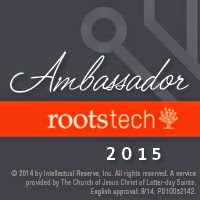 Still need to register, or need more information? Head over to the RootsTech website.
Still need to register, or need more information? Head over to the RootsTech website.
 most common searches are:
most common searches are: “You’ll find it under the search box. My initial search for my husband’s great grandfather resulted in tens of thousands of hits until I included mandatory keywords, his name as a phrase, a defined time frame, and zeroed in on advertisements. The 299 results were far more manageable and resulted in several fantastic finds!”
“You’ll find it under the search box. My initial search for my husband’s great grandfather resulted in tens of thousands of hits until I included mandatory keywords, his name as a phrase, a defined time frame, and zeroed in on advertisements. The 299 results were far more manageable and resulted in several fantastic finds!”


 I think you are on the right track with newspapers.
I think you are on the right track with newspapers. 




 Still need to register, or need more information? Head over to the
Still need to register, or need more information? Head over to the 


